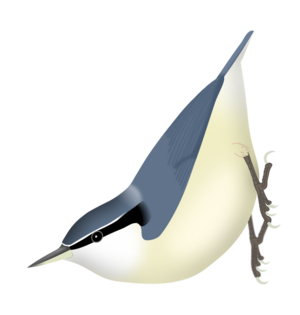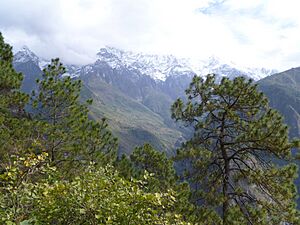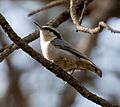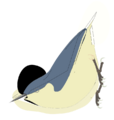Yunnan nuthatch facts for kids
Quick facts for kids Yunnan nuthatch |
|
|---|---|
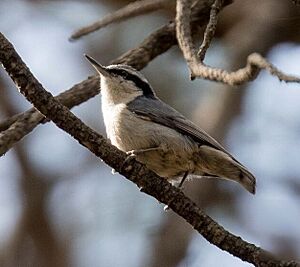 |
|
| In Black Dragon Pool, Yunnan, China | |
| Conservation status | |
| Scientific classification | |
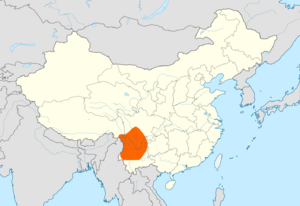 |
|
| Range of the Yunnan nuthatch |
The Yunnan nuthatch (Sitta yunnanensis) is a small bird that belongs to the nuthatch family. It was first described in 1900 by William Robert Ogilvie-Grant. This bird is about 12 centimeters (4.7 inches) long and weighs between 7.5 and 13 grams (0.26 to 0.46 ounces).
The Yunnan nuthatch has grey-blue feathers on its back and a light, creamy color on its belly. It has a thin white stripe above its eye and a black stripe through its eye. The black eye stripe is very clear when the bird's feathers are new. Male and female birds look quite similar, but there are small differences. This bird is known for being noisy and makes simple, nasal sounds. Sometimes, it repeats these sounds many times.
We don't know a lot about how it lives, but it eats insects it finds on pine tree branches. You can find the Yunnan nuthatch in Southwest China, mainly in the areas of Yunnan, Sichuan, and Guizhou. It likes pine forests that are not too dense and avoids thick spruce and fir forests. The bird is listed as a near-threatened species on the IUCN Red List. This means its population might be at risk in the future. It is generally rare, but you can find many of them in some local areas. Its home range is about 170,000 square kilometers (65,600 square miles). A study in 2009 suggested that its population could drop by 43.6–47.7% between 2040 and 2069.
Contents
About the Yunnan Nuthatch
How the Yunnan Nuthatch Was Named
The Yunnan nuthatch was first named Sitta yunnanensis by a Scottish bird expert, William Robert Ogilvie-Grant, in 1900. He named it after studying a male bird found in southern Yunnan. This bird does not have any different types or subspecies.
Nuthatch Family Tree
The Yunnan nuthatch is part of a group of six nuthatch species called the canadensis group. This group also includes the red-breasted nuthatch, Chinese nuthatch, Corsican nuthatch, Krüper's nuthatch, and Algerian nuthatch. Scientists have studied the DNA of these birds. In 2014, a study confirmed that the Yunnan nuthatch is the oldest species in this group, meaning it was one of the first to evolve.
| Nuthatch phylogenic detail according to Pasquet, et al. (2014): | |||||||||||||||||||||||||||||||||
|---|---|---|---|---|---|---|---|---|---|---|---|---|---|---|---|---|---|---|---|---|---|---|---|---|---|---|---|---|---|---|---|---|---|
|
What the Yunnan Nuthatch Looks Like
The Yunnan nuthatch has blue-grey feathers on its back and head. It has a thin white line above its eye that reaches its forehead. Below this, there is a black stripe that goes through its eye and gets wider towards its back. Its eye has a thin white circle around it, and its cheeks and throat are white. The feathers on its belly are a plain, light pinkish-cream color.
Its beak is thin and pointed. The top part of its beak is almost straight, which makes the tip look like it's pointing up. Its eyes are dark brown. The beak is grey-black, with the bottom part being yellowish. Its legs and feet are grey-brown. The Yunnan nuthatch is a small bird, usually around 12 cm (4.7 inches) long. Its wing length is about 69.5 to 74 mm (2.7 to 2.9 inches) for males and 67 to 74 mm (2.6 to 2.9 inches) for females. The tail is about 35 to 41 mm (1.4 to 1.6 inches) long for males and 36 to 38 mm (1.4 to 1.5 inches) for females.
Differences Between Males and Females
Male and female Yunnan nuthatches look very similar. However, the black eye stripe on females is usually not as dark, and their belly feathers are duller and more grey.
How Feathers Change
The bird's feathers are freshest from August. They slowly wear out until the next spring. When the feathers are worn, the white tips of the eyebrow feathers disappear, and the eyebrow line might not be continuous. The back feathers become duller and less blue. The tail and wing feathers also wear out, but the blue-grey tips of the tail feathers stay until at least May. The belly feathers become duller and dirtier, turning a greyish-white.
Young birds are duller than adult birds. Their eyebrow is less clear and doesn't reach the forehead. Sometimes, it's almost gone. The eye line is also not as wide, and the cheek is dirty grey instead of white. The throat is whiter, but the rest of the belly feathers are duller and greyish-cinnamon. Adult birds completely change their feathers from July to September. Sometimes, they might change some chest feathers before the breeding season in January and February.
Similar Birds
The giant nuthatch can live in the same places as the Yunnan nuthatch. However, the giant nuthatch is much bigger and does not have a white eyebrow. The chestnut-vented nuthatch is similar in size to the Yunnan nuthatch, but it has reddish sides and no white eyebrows.
Ecology and Behaviour
Vocalizations: What Sounds Do They Make?
The Yunnan nuthatch is a fairly noisy bird. It makes many different sounds like nit, kni, tit, pit, or a low, nasal toik. Its main call, nit, is often repeated in groups of five to six times per second, lasting four to ten seconds. This creates sounds like kni-kni-kni, kit-kit-kit, pi-pi-pi, or a nasal niew-niew-niew. It also makes a harsh schri-schri-schri or szi-szi-szi call, which is common for other small nuthatches. Sometimes, it makes a ziew-ziew-ziew call in calm groups of three notes per second. It can also make nasal calls like quit-quit-quit, schu-schu-schu, or tui-tui-tui.
Food and Reproduction
We don't know much about what the Yunnan nuthatch eats, but it is known to catch and eat insects from pine branches. There is also not much information about how they reproduce. However, one female bird was found on March 9 that was almost ready to lay eggs. Young Yunnan nuthatches were found on May 21, meaning they had recently hatched.
Where the Yunnan Nuthatch Lives
The Yunnan nuthatch lives only in Southwest China. It is mainly found in the areas of Yunnan, Sichuan, and Guizhou. A study in 2003 confirmed that this bird lives only in China, with the Hengduan Mountains being its main home. However, it has also been seen in the Anjaw district of Arunachal Pradesh in India.
The Yunnan nuthatch does not migrate; it stays in the same area all year. It lives in pine forests where the trees are not too close together. It avoids dense spruce and fir forests. Sometimes, it lives on small pine trees that are 2 to 3 meters (6.6 to 9.8 feet) tall, in open forests or among scattered groups of trees. In the summer, it lives at high altitudes, between 2,440 and 3,960 meters (8,010 and 12,990 feet) above sea level. In winter, it moves down into valleys to heights as low as 1,200 meters (3,900 feet). However, it has been seen at 2,600 to 4,000 meters (8,500 to 13,100 feet) between November and January in Shuangbai County.
Threats and Protection
In 1987, a Chinese bird expert named Zheng Zuoxin said the Yunnan nuthatch was rare. However, it can be common in some places, like the pine forests of Lijiang. Its home range is small, about 170,000 square kilometers (65,600 square miles). The bird disappeared from several locations in the early 1900s.
The Yunnan nuthatch is threatened by the destruction of its habitat. It depends on old pine forests, but it can also live in areas where the forests are not in perfect condition. A 2009 study looked at how climate change might affect nuthatches in Asia. It showed that the Yunnan nuthatch's population could shrink by 43.6% to 47.7% between 2040 and 2069. Because of these threats, the species is listed as near-threatened species by the International Union for Conservation of Nature.
Images for kids



